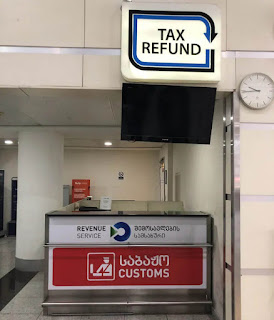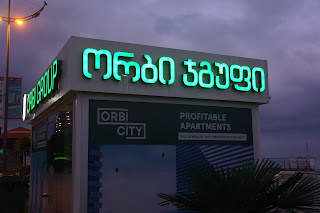Long-Stay in The Dominican Republic and Public Transportation to Santo Domingo Airport (SDQ) by Bus
The Dominican Republic is a laid-back destination for those looking for a long-stay. When overstaying, you don't need to deal with the immigration office and apply for an extension. You simply pay according to the time you have spent in the country when leaving.
We discovered the charms of the Dominican Republic by accident. We had been visiting Guadeloupe and searched for an affordable exit flight. That happened to be to Santo Domingo which had never been on our list of favourite destinations. However, we decided to take advantage of the cheap airfare and stay a couple of days in the city before continuing onwards, but we soon decided otherwise. The climate was great, people were friendly, there were not too many tourists around, and the prices were affordable compared to other Caribbean islands. When we found a place to rent in the beautiful Colonial Zone without much effort, we decided to give it a try and ended up loving it.
Long-stay payments for staying over 30 days in the Dominican Republic
Here is what we learned about long-stay in the Dominican Republic. Although The International Air Transport Association IATA is misleading travellers to think they will get a free 90-day stay, this is not the case with the Dominican Republic. In reality, you will get 30 days, and you will be charged for any extra time you spend in the country. The fee can be paid in local currency and it is collected at the airport when leaving, just before the passport control. Here is the current fee table as of today. On the Internet, there is a lot of contradicting information about the cost and limit of overstay. The immigration website is selling extensions online and claims that the maximum stay in the country is 120 days while the Punta Cana airport has a pricelist up to ten years of overstay for 70,000 DOP/US $1,703. Santo Domingo Airport had a similar price list up to 10 years.
When entering, we did the required Electronic Ticket registration to get the QR code that was supposed to be required for entering and exiting the Dominican Republic, but nobody wanted to see any QR codes when arriving, not even the airline. On departure some border guards wanted to see QR codes. That caused huge queues and delays when people were sent back to fill the electronic forms, and some probably missed their flights in the process. One wonders if they are just collecting private information from unsuspecting tourists in order to sell it to third parties. Their online extension selling system also felt like a data harvesting scheme.
Santo Domingo Airport (SDQ) transportation by public bus for US $2
Another practical tip about arriving and leaving the country. There is an annoying airport taxi mafia in Santo Domingo Airport (Las Américas International Airport Dr. José Francisco Peña Gómez) just like in many other third world tourist destinations in the world. If you take a taxi, you will pay around US $24-60 while a bus ride costs only US $2. Note however that buses do not go all the way to the airport or leave straight from the airport. You need to walk out and then continue to the north to the Santo Domingo highway called Autopista Las Americas. The distance to the bus stop is about two kilometres (1.3 ml). There is a pathway, and the only tricky part is to cross the highway where everyone is driving to kill. The local bus station is on the other side of the highway about 150 metres (500 ft) towards Santo Domingo.
In Santo Domingo, buses to the airport leave from Enriquillo Park. You can take any bus going to Boca Chica, La Romana or Punta Cana. No matter how fancy or crappy the bus looks, they all charge you the same. In a minibus you might have to buy an extra seat for your luggage if you can't fit it on the floor or in front of you. We felt that buses are more trustworthy than taxis and wanted to avoid haggling, last minute price changes and the risk of getting robbed by a taxi driver.
Lovely, noisy and trashy Malecon
Why stay in Santo Domingo? The best thing about the city, for us, was Malecón. This long beach boulevard is great for exercising in the early morning hours. At that time, it is not crowded and the traffic in the nearby four-lane street is tolerable. During the daytime the noise is horrible and crossing the street mortally dangerous. During our three-month stay, we saw many accidents, mostly involving cars and motorcycles. It would be a great improvement if the government decided to make the city center and Malecón car-free. Now even huge American trucks drive along it polluting the air. We enjoyed tremendously those few Sundays when Malecón was completely closed for traffic. This happened during the Santo Domingo marathon and another running event.
While you can admire incredibly beautiful sunrises from Malecón, the beaches are not good for swimming or sunbathing as they are filled with plastic waste. Once in a while groups of volunteers do a cleaning effort (themselves drinking water from single-use plastic bottles), but the shore soon looks the same. People just don't care, and restaurants keep selling throw-away packaged lunches and drinks in plastic bottles that end up on the beach and in the ocean killing fish and eventually people who eat fish. Päivi boiled tap water and Santeri drank it unboiled without any problems.
Electric nightmare
Among other downsides in Santo Domingo are constant interruptions in electric power. Local wiring is a mess and when something goes wrong, blackouts can last from hours to days. The longest inconvenience we experienced was eighteen hours. Usually there are a few blackouts every week and they last from two to four hours. The local electricity company has no interest in doing their job well. When they came to change our electric meter, they forgot to reconnect the electricity. It was Saturday afternoon and the guys hurried back home. That night we enjoyed a surreal setting: we sat in the dark watching our neighbours hanging blinking Christmas lights on their balconies.
Peace and price control
Foodwise, Santo Domingo is affordable. You can eat out with US $3 if you choose a popular lunch joint instead of an à la carte restaurant. Being vegans we didn't find much choice in restaurants so we cooked by ourselves. Food in supermarkets is very affordable and local fresh produce wonderful. We especially enjoyed the Dominican avocados, pumpkins and papayas. While there are many supermarket chains in the city, competition is lacking and selection is almost identical. Food prices seem to be controlled and the same applies to gasoline and currency exchange rates which feel artificially expensive. Obviously the government do not want people to riot and march in the streets as in many other countries in the world, including the neighbouring Haiti. The only protest we saw was against domestic violence. A small group of women was standing in the street holding protest signs.
For Americans and Europeans, flights to the Dominican Republic are cheap. There are many airlines flying either to Santo Domingo or to Punta Cana, and they often have promotions. The high season is from December to March. We stayed during the hurricane season which runs from September to November, and found it surprisingly pleasant. One hurricane came close but it missed us by some 50 kilometers (30 ml). In the aftermath, there was a strong wind and some rain causing a short blackout for a couple of hours. During the whole fall, rain was moderate. It usually rained in the afternoon and the rest of the day was nice and sunny. Temperatures were occasionally high coupled with high humidity. If you don't like tropical weather, fall is probably not the time to travel to the Dominican Republic. The high season is cooler and drier.
Let's cancel cars, OK?
Let's cancel plastic trash, OK?
Our travel videos are available at videos.nomadtravelbooks.com.








Comments